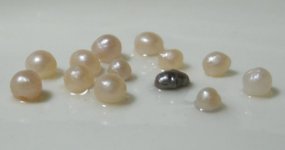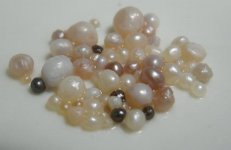Lagoon Island Pearls
Well-known member
- Joined
- Dec 8, 2009
- Messages
- 2,006
I recently undertook an expedition to survey to my research areas. Among valuable data gathered on ocean acidification, paralytic shellfish poisoning, sea star mortality and invasive species, I managed to harvest a few terrific pearls.

A wonderful off-round 6.9mm silver/gray pearl.

Some of the nicer champagne pearls of the lot. Also in the image is a black dragon's eye. Despite their dark rich color, they are still remarkably translucent. Expect to see these to be candled and posted in a few days.

These are from the first few days of the expedition.

These are from the final days of the survey. The size averages were smaller than normal, but I was impressed by the broader range of colors.

A wonderful off-round 6.9mm silver/gray pearl.

Some of the nicer champagne pearls of the lot. Also in the image is a black dragon's eye. Despite their dark rich color, they are still remarkably translucent. Expect to see these to be candled and posted in a few days.

These are from the first few days of the expedition.

These are from the final days of the survey. The size averages were smaller than normal, but I was impressed by the broader range of colors.
